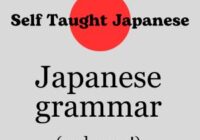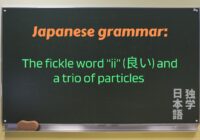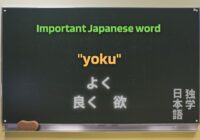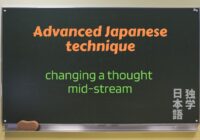Category Archives: grammar
Japanese grammar and more! (Episode 5: the negative verb tense)
Japanese grammar and more! (Episode 4: existence verbs, “ga” and “ni” particles, etc.)
Japanese grammar and more! (Episode 3: 1st person pronouns, the “yo” particle, an everyday greeting…)
In the 3rd episode of my new Podcast about learning Japanese, I touch on the following topics: Introduction to first person pronouns Using the particle “yo” Vocabulary words related to drinks or drinking (“coffee”, etc.) Using people’s names in a sentence. A common greeting You can also hear this episode on Spotify here (along with… Read More »
“Japanese grammar and more!” Episode 2
A new podcast about learning Japanese: “Grammar and more!” (Episode 1)
Japanese bilingual reader book release: “Kantan! Read Japanese stories like a native (Volume 2)”
Japanese grammar: the fickle word “ii” (良い) and a trio of particles
After studying a foreign language for a certain amount of time, you develop a level of confidence about grammar and commonly used words. But for all of us that have learned a language as a non-native, there comes a time when we fail to use even the simplest of words properly, resulting in disastrous consequences…… Read More »
Important Japanese word: よく (yoku)
In this post I want to highlight a common and important word in the Japanese language, “yoku”. It can be written in hiragana as よく, and depending on the meaning can also be written in kanji as 良く or 欲. The first meaning I would like to go over is the most common one, which… Read More »
Advanced Japanese technique: changing a thought mid-stream
As we learn a foreign language, we gradually improve our vocabulary, grammar, and pronunciation, and at the same time gain other more abstract skills that help us understand and communicate better. Often these things happen subconsciously, but you can also learn these types of skills explicitly and try to apply them to your daily language… Read More »





